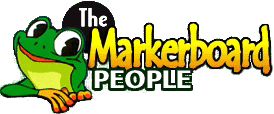The Tactile Magic of Dry Erase

In an age dominated by digital devices and technology, the tactile experience often takes a backseat to the allure of screens and sleek interfaces. However, there's something timeless and invaluable about tactile feedback that makes dry erase boards a preferred choice over tablets, especially in certain settings. In this post, we'll dive into the significance of tactile feedback, explore why dry erase boards remain indispensable in various situations, and shed light on their enduring appeal.
Tactile feedback refers to the physical sensation we experience when we touch or interact with an object. It's that satisfying "click" of a keyboard key or the resistance of a button press. Tactile feedback connects us to our physical world and enhances our understanding and interaction with it. This sense of touch is deeply ingrained in our everyday lives, and it plays a pivotal role in learning and communication.
Dry erase boards epitomize tactile feedback. When you pick up a dry erase marker and start writing on the board, you're engaging with a physical, tangible object. There's a certain pleasure in the smooth glide of the marker across the board and the sensation of creating something tangible with your own hands.
Why Tactile Feedback Matters
Research has shown that tactile feedback enhances memory retention and comprehension. When you physically write something down on a dry erase board, your brain forms a stronger connection to the material, making it easier to remember and understand.
Dry erase boards promote active engagement. They invite collaboration and discussion as participants can physically interact with the board, drawing diagrams, writing notes, and making annotations. This hands-on approach encourages a deeper understanding of concepts.
In the world of tablets, notifications, apps, and the ever-tempting rabbit hole of the internet can easily distract us. Dry erase boards offer a distraction-free environment, allowing you to focus solely on the task at hand.
Dry erase boards are universally accessible. You don't need to worry about compatibility issues, battery life, or software updates. Anyone, regardless of their technological prowess, can use a dry erase board effectively.
-
Education: In the classroom, tactile feedback is paramount for effective learning. Dry erase boards make lessons interactive and memorable. They encourage students to actively participate, whether it's solving math problems, illustrating scientific concepts, or practicing handwriting.
-
Brainstorming and Collaboration: When it comes to brainstorming and collaboration, dry erase boards reign supreme. They facilitate lively discussions, idea sharing, and visual thinking. The physical act of writing and erasing allows for spontaneous creativity that digital tools often lack.
-
Workplace Productivity: In the workplace, dry erase boards are ideal for planning, organizing, and strategizing. They offer a clear, immediate overview of tasks and projects. Plus, they eliminate the need for constant device switching, enhancing efficiency.
While digital devices have their place in our lives, dry erase boards demonstrate that tactile feedback is far from outdated. Their enduring appeal lies in their ability to enhance memory, foster interactivity, reduce distractions, and provide universal accessibility. In an age of screens, the tactile sensation of a dry erase board remains an irreplaceable asset, whether in classrooms, brainstorming sessions, or offices. So, don't forget to keep a dry erase board on hand for those moments when the physical connection with your ideas and concepts truly matters.



